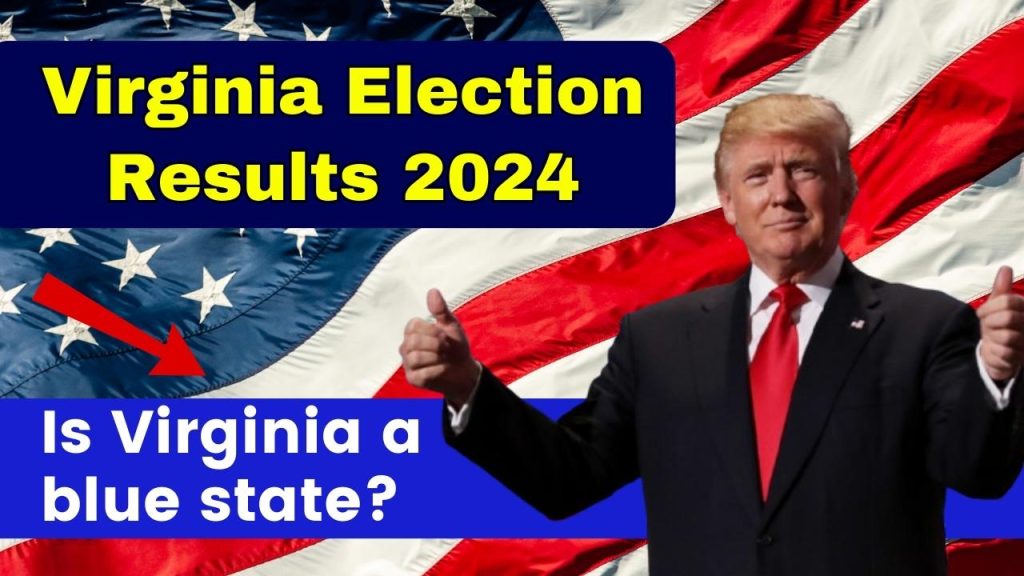Virginia Election Results 2024: As the 2024 U.S. election season wraps up, one of the biggest questions is: Is Virginia a blue state? Known for its historical significance and complex political landscape, Virginia has undergone a noticeable shift over the past few decades, from a reliably red state to a Democratic-leaning battleground. The 2024 election results reveal more about this shift, providing insights into Virginia’s political identity and future role on the national stage. This article examines Virginia’s political transformation, the key factors shaping its current political leanings, and the potential implications for future elections. Read on to understand why Virginia Election matters so much in U.S. politics today.

Virginia Election Results 2024
| Category | Detail |
|---|---|
| Political Shift | Virginia has shifted from a historically red state to a battleground with Democratic (blue) tendencies. |
| 2024 Election Results | Democrats won in key urban areas, while Republicans held rural strongholds. |
| Voting Trends | Higher voter turnout in urban areas, with increased engagement among younger and minority voters. |
| Population Growth | Growth in urban and suburban areas has influenced voting patterns. |
| Link to Official Results | Official Virginia Election Results |
Virginia’s political transformation from a conservative stronghold to a Democratic-leaning battleground underscores the impact of urbanization, demographic changes, and evolving policy preferences. The 2024 election results reflect Virginia’s blend of Democratic support in urban areas and Republican backing in rural regions. As a pivotal player in U.S. elections, Virginia’s mix of voters and issues ensures its influence in shaping the nation’s political future.
Understanding Virginia’s Political Background
Historically, Virginia was a Republican stronghold. For much of the 20th century, it consistently supported conservative candidates in state and federal elections. However, starting in the early 2000s, Virginia’s political landscape began to shift, influenced by a combination of changing demographics, population growth, and evolving policy priorities. This transformation marked the start of Virginia’s journey from solid red to a battleground or “purple” state, with a recent trend toward Democratic, or blue, leanings.
Key areas of Virginia—such as Northern Virginia (close to Washington, D.C.), Richmond, and the Tidewater area—have seen significant urban growth and demographic diversification, bringing an influx of younger, educated, and ethnically diverse residents who tend to favour Democratic policies. On the other hand, rural Virginia has maintained its conservative roots, supporting Republican candidates and policies.
This balance of blue urban centers and red rural areas creates a unique political landscape, making Virginia a closely watched state in both state and national elections.
Election Results Overview: Virginia 2024
The 2024 election results highlight the complexities of Virginia’s political identity, showing a clear divide between urban and rural areas. Here are some highlights from this year’s results:
- Governor and State Legislatures: Democratic candidates retained control of key urban districts, with strong performances in Northern Virginia and Richmond. Meanwhile, Republicans held firm in rural areas, particularly in the western and southern parts of the state.
- Senate and House Seats: Virginia’s Congressional representation remains split, with Democrats taking urban districts and Republicans securing rural seats. This division continues the trend of Virginia as a state with a mixed political landscape.
- Voter Turnout: Virginia witnessed a high voter turnout in 2024, particularly among younger and minority voters. This increased engagement was most notable in urban centers such as Richmond, Alexandria, and Arlington, where turnout numbers reached record highs.
These results underscore the shift towards Democratic support in Virginia’s urban and suburban areas, while rural regions maintain a solid base of Republican support.
Key Factors Influencing Virginia’s Political Shift
Several factors have influenced Virginia’s evolution from a traditionally red state to a battleground with Democratic leanings:
1. Urbanization and Population Growth
The growth of Virginia’s urban population has been a major contributor to its political shift. Cities like Richmond, Arlington, and Norfolk have expanded due to job opportunities, high-quality educational institutions, and affordable living options. This urbanization has attracted younger, more progressive residents who support Democratic policies.
For instance:
- Northern Virginia (especially Fairfax and Loudoun counties) has seen a surge in young, educated, and ethnically diverse residents. This region, in proximity to Washington, D.C., has leaned heavily Democratic in recent years.
2. Demographic Changes
Virginia’s demographic shifts have played a significant role in its political transformation. A larger, more diverse population brings a variety of perspectives on key issues, such as healthcare, education, and economic growth.
- Increasing Minority Representation: Virginia’s Black, Latino, and Asian communities have grown and shown strong support for Democratic candidates, aligning with party policies on social issues and economic reforms.
- Youth Participation: In 2024, younger Virginians (ages 18-30) turned out in record numbers, driven by issues like climate change, reproductive rights, and student debt. This demographic leans Democratic, with around 60% supporting Democratic candidates in recent elections.
3. Suburban Voting Trends
Virginia’s suburbs have become a political battleground. Suburban voters are often focused on quality-of-life issues such as education, healthcare, and property taxes. These concerns make them a valuable demographic for both parties.
- In the 2024 elections, Loudoun and Prince William counties swung toward Democratic candidates, reflecting the preferences of suburban residents concerned with progressive social policies and local economic issues.
4. Impact of Key Policies on Voter Preferences
Specific policies play a role in Virginia’s shifting voter base. Democratic policies on climate action, healthcare reform, and educational funding have resonated with urban and suburban voters, while Republican stances on gun rights and lower taxes continue to appeal to rural voters.
Virginia’s Political Identity Affects National Politics
Virginia’s position as a battleground state has national implications, particularly in elections for Congress and the presidency.
- Senate and House Control: Virginia’s mix of Democratic and Republican representatives reflects the state’s unique political composition, influencing which party controls the Senate and House.
- Presidential Elections: With its 13 electoral votes, Virginia plays a significant role in presidential elections. Democratic gains in Virginia bolster their national path to victory, while Republicans target rural areas to strengthen their hold in the state.
Virginia’s status as a battleground means that both parties invest heavily in campaign efforts to secure votes, especially in competitive regions like Northern Virginia and Richmond.
$16,800 Expense Payment Aid Only For These Americans In November 2024: Check How to get it
Social Security Payments Halted This Week in November 2024: Check Your Eligibility and Amounts
$8000 SSI Hike For Married SSI Recipients In 2024: Know Eligibility & Application Process
Practical Insights for Voters and Politicians
Virginia’s political landscape is constantly evolving, requiring both voters and politicians to stay informed and engaged. Here are a few tips for navigating the state’s political environment:
- Stay Informed on Local Issues: Virginia’s elections often center on state-specific issues, such as transportation, infrastructure, and K-12 education. Staying informed about these local priorities helps voters make educated decisions.
- Participate in Community Events: Local events like debates, town halls, and community forums allow voters to hear directly from candidates about issues that matter most in their districts.
- Focus on Key Demographics: For political strategists, understanding the preferences of Virginia’s young voters, minority groups, and suburban residents is essential for success in future elections.
FAQs
1. Has Virginia always been a blue state?
No, Virginia was historically a red (Republican) state. Over the past two decades, demographic shifts and growth in urban areas have shifted its political leanings toward the Democratic Party.
2. What factors have made Virginia a battleground state?
Virginia’s political identity is shaped by urbanization, increased minority representation, and higher political engagement among young voters, making it a closely contested state.
3. Which regions in Virginia tend to vote Democratic?
Northern Virginia, Richmond, and the Tidewater area typically favour Democratic candidates due to their large, diverse populations and urban settings.
4. How does Virginia impact national elections?
Virginia’s 13 electoral votes are crucial in presidential elections, and its Congressional seats can influence the balance of power in the House and Senate.
5. Will Virginia remain a blue-leaning state?
While Virginia leans Democratic in many areas, its battleground status means that it could swing depending on future demographic changes and policy priorities.

